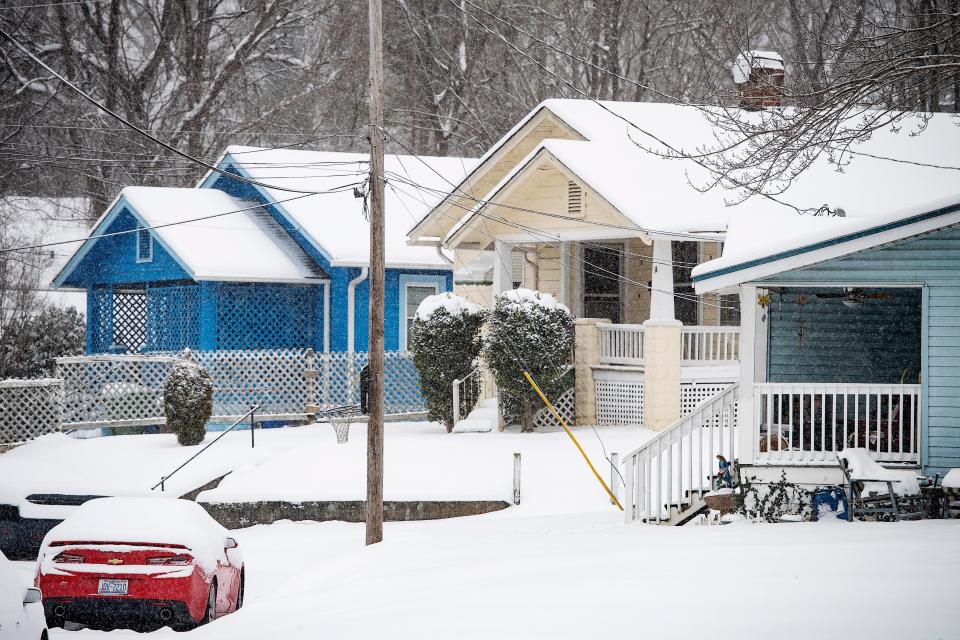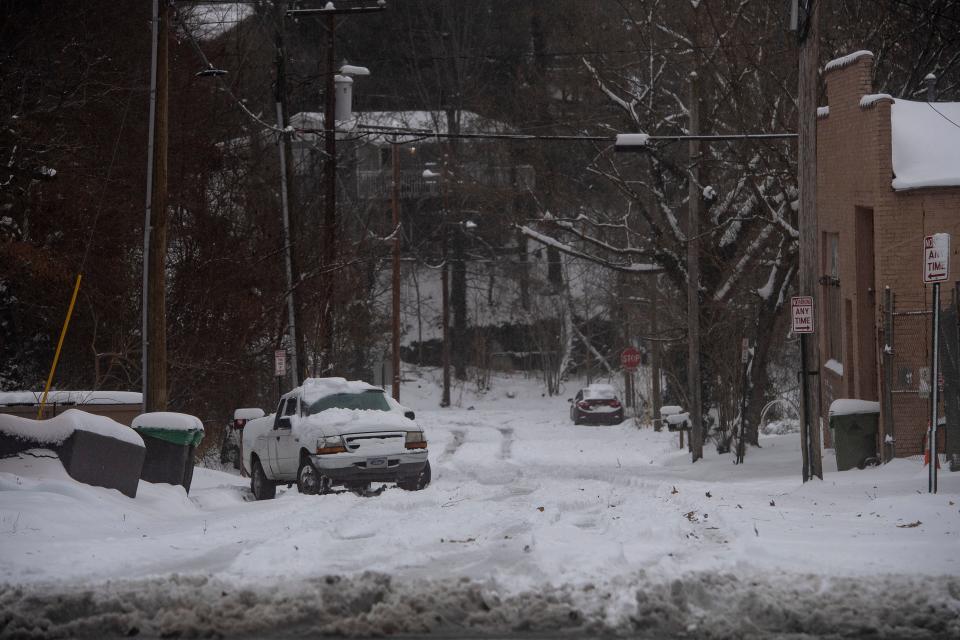Are you ready for winter weather in Western North Carolina? Here's our checklist
ASHEVILLE - As winter and cold temperatures settle in, Western North Carolinians can plan ahead for potential weather hazards.
When winter weather does come calling, it can mean snow and ice storms, which are often accompanied by power outages, burst pipes and dangerous road conditions.
Here's some things you need to know to be prepared ahead of any impending winter weather this season.

Preparing for winter weather
During December, both the city of Asheville and Buncombe County offered weather preparedness tips for area residents. Top of the list, advises emergency managers, is staying informed and paying close attention to the latest weather forecasts using local media or National Weather Service alerts.
"It’s important to know what different winter weather headlines mean and even though the criteria for winter weather watches, warnings and advisories vary across North Carolina they all have the same premises," said a Dec. 4 county news release, so remember:
Winter Storm Watch is issued when conditions are favorable for either heavy snow, sleet, or freezing rain within the next 24-48 hours.
Winter Storm Warning is issued when confidence is high that a winter storm will cause significant impacts within the next 12-36 hours.
Winter Weather Advisory is issued when wintry weather is expected and residents should exercise caution as light to moderate amounts of snow, sleet, or freezing rain are expected within the next 12-36 hours, causing travel difficulties.
To help ensure you are ready for winter weather, emergency managers suggest keeping at least a three-day supply of non-perishable food as well as medications in your home, along with fresh batteries on hand for weather radios and flashlights. Be sure to dress warmly by wearing multiple layers of thin clothing instead of a single layer of thick clothing.
Don’t forget to include pets in your emergency plans.
More: What to know: How can you find emergency homeless shelter on freezing nights in Asheville?
Protect your pipes
The city of Asheville's Water Resources Department recommends best practices to avoid frozen pipes:
Disconnect and drain all garden hoses and install covers on outside faucets.
Keep garage doors closed.
Open kitchen and bathroom cabinet doors to allow warmer air to circulate around the plumbing.
Identify water shut-off valve locations, and know how to operate them.
Wrap pipes nearest to exterior walls and in crawl spaces with pipe insulation or heating tape.
Regulate indoor temperature around the clock, primarily by keeping your thermostat set to the same temperature during the day and at night. Temporarily suspending the use of lower thermostat settings at night may raise your heating bill, but it can lower the chances of a frozen and busted pipe causing potentially serious damage to your home. Water damage repairs are expensive, and can potentially displace you from your home for weeks or months at a time.
Close all windows near water pipes, and cover or close open-air vents. Freezing temperatures combined with drafts of cold air can raise the likelihood that pipes will freeze.
Set faucets at a slow drip when extreme cold is in the weather forecast if pipe insulation or other suggested tips are not applicable. For example, if the temperature isn’t expected to rise above freezing, even during daylight hours, you should drip those faucets.
If you believe thatyour water meter is frozen, contact the city's Water Resources Department customer service by calling 828-251-1122.
Heating a home if using a kerosene heater
Tips on kerosene heater use from the city:
Ventilation: Use kerosene heaters in well-ventilated areas to prevent carbon monoxide build-up.
Regular maintenance: Keep your heater in good condition by regularly cleaning and servicing it.
Store fuel safely: Store kerosene in approved containers away from living spaces.
Keep an eye on children and pets: Make sure young children and pets are not left unattended around kerosene heaters.
Be sure to only use kerosene oil and no other fuel for a kerosene heater.

Driving in winter weather
While the N.C. Department of Transportation "proactively plans" for winter weather and has crews ready to clear roads, it can be dangerous driving during and after rain, ice or snow. NCDOT spokesperson Jen Goodwin referred to these winter driving tips:
Before Driving
Be sure your vehicle is running well and equipped properly for driving on potentially dangerous roads.
You should have a supply kit that includes an ice scraper, snow brush, extra windshield wiper fluid and anti-freeze and a basic automotive tool kit that includes jumper cables and flares.
Put the supply kit in your trunk in case you get stranded. Include a flashlight, first-aid kit, blanket, shovel, sand (to give tires traction), non-perishable snacks and drinking water and safety flares.
Be sure you have at least a half-tank of gas in your vehicle (short commutes can turn into long ones when a storm hits) and a full reservoir of windshield washer fluid.
Black Ice
Appearing as wet spots on a road, black ice is often the result of melting ice and snow that refreezes into thin layers.
It is unpredictable, said the NCDOT post, and most of the time, drivers aren't aware of it until it's too late.
Don't drive unless you absolutely have to do so. The safest way to avoid black ice is to stay off the roads.
If you do have to drive, do so at a slow speed and leave plenty of space between you and the vehicle in front of you.
If you start to slide
Don't panic.
Avoid using your brakes, if possible. If you have to, use them gently. (Apply gentle, steady pressure to anti-lock brakes. For standard, brakes that are not anti-lock, pump the brake pedal gently to avoid locking up).
Wait for your vehicle to slow down enough to regain traction before gently accelerating.
For rear-wheel skids, turn the steering wheel in the direction your rear wheels are headed. Instead of focusing on what your vehicle might be headed toward, focus on getting out of the skid.
For front-wheel skids, shift into neutral and don't try to steer immediately. When your vehicle begins to slow down, steer in the direction that you want your vehicle to go. Then, put the vehicle into gear and gently accelerate.
If you begin to slide, take your foot off the gas and turn the steering wheel in the direction of the slide. Applying the brakes will cause you to further lose control of your vehicle.
Learn more
For more information on how to prepare for winter storms, visit www.readync.gov. Get local alerts sent straight to your smartphone, email, or home phone with BC Alerts via CodeRED or AVL Alert, the city's emergency and non-emergency notification system. Sign up: ashevillenc.gov/service/sign-up-for-avl-alert.
More: WNC hiking: Best winter hiking spots for the holidays
More: Who is running in Asheville, Buncombe 2024 primary election? See full candidate list
Sarah Honosky is the city government reporter for the Asheville Citizen Times, part of the USA TODAY Network. News Tips? Email shonosky@citizentimes.com or message on Twitter at @slhonosky. Please support local, daily journalism with a subscription to the Citizen Times.
This article originally appeared on Asheville Citizen Times: WNC winter weather checklist: Tips to prepare for inclement weather

